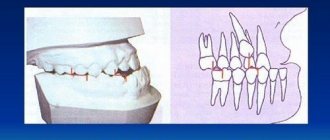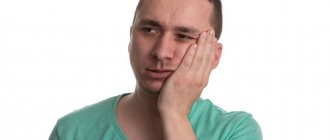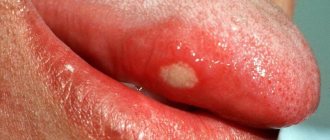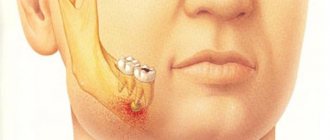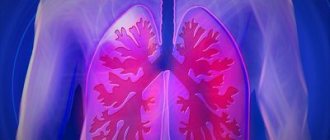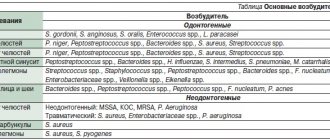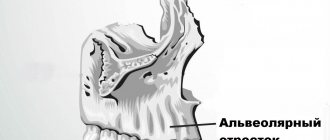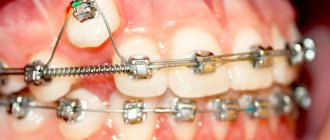1225
In the treatment of Angle class 3 anomalies of the dentofacial system, experts note the effectiveness of the chin sling when it is used in combination with an orthodontic apparatus.
It has been proven that in children who regularly and for a long time use a device for extraoral traction, the proportions of the maxillofacial region change due to resorption of the angle of the movable jaw.
Many orthodontists believe that when used correctly, the device can redirect the growth of the lower jaw and rotate it backwards.
The chin sling is also used for serious jaw injuries (for example, fracture) as a means of immobilization. By pressing the lower jaw, the sling-shaped bandage immobilizes it, providing conditions for bone fusion and preventing displacement of jaw fragments.
General information and purpose
A chin sling for immobilizing jaws during fractures is a first aid remedy that accelerates the healing of the affected joint. It looks like a bandage consisting of a soft and hard part (linings) that are fixed in the chin area.
Ribbons with laces are used as fastening elements, which are attached to the back of the head.
Purpose;
- temporary immobilization of the jaw when delivering the patient to the traumatology department:
- use for medicinal purposes until the bone is completely fused.
In addition, the device is used when it is impossible to provide emergency complex therapy due to the serious condition of the victim. The bandage is applied for 2-3 days or more until a satisfactory condition occurs. In this case, the traumatologist must take into account the possible risks of improper fusion of the fragments.
The chin sling for correcting malocclusion is an extra-oral orthodontic appliance. It is made in the form of a plastic pad or a bandage made of dense fabric. Attaches to the head cap using elastic rubber rings. The tension is adjustable.
Orthodontic appliances are most often used for open, mesial bites in children, excessive growth of the lower jaw and insufficient facial height, which are characterized by the following changes:
- violation of facial aesthetics due to the mesial position of the movable jaw;
- protrusion of the chin area;
- reduction of the lower third of the face;
- retraction of the upper lip with thickening of the lower lip;
- concave profile;
- arrangement of elements of the anterior section in the reverse overlap;
- retrusion of the upper teeth;
- negative changes in the relationship of the dentition.
Remarkable. For mesial occlusion, a sling is used, the thrust of which is beveled posteriorly. With open occlusion, vertical upward traction is advisable.
Why is hardware treatment for malocclusion considered the most effective?
Come here for a closer look at the buttons used in orthodontics.
At this address https://www.vash-dentist.ru/ortodontiya/prikus/impaktnyiy-zub.html we will understand what impact teeth are.
Cost of bite correction
Make an appointment
| Service | Price |
| Consultation | 750 rub. |
| Consultation with calculation of treatment time and cost | 1200 rub. |
| Calculation of anthropometric jaw models | 1200 rub. |
| Cast from the 1st jaw | 600 rub. |
| Casting the 1st plaster model | 600 rub. |
| Bite pattern, determination of constructive bite | 1200 rub. |
| Consultation with training in massage, myogymnastics | 1800 rub. |
| Grinding of the 1st baby tooth | 500 rub. |
| Oral hygiene training with orthodontic appliances | 600 rub. |
| Treatment with removable equipment | |
| Plate without screw | 13200 rub. |
| Plate with 1 screw | 13800 rub. |
| Plate with 2 screws | 15400 rub. |
| Klammt apparatus | 27600 rub. |
| Twin block device | 31200 rub. |
| Removable denture with artificial teeth | 13200 rub. |
| Visit with 1st record | 800 rub. |
| Visit with 2 records | 1200 rub. |
| Visit with the Klammt activator | 1000 rub. |
| One artificial tooth | 600 rub. |
| Repairing the device (simple) | 3600 rub. |
| Repairing the device (complicated) | 4100 rub. |
| Repairing the device with the introduction of additional screws, springs, cuts | 7200 rub. |
| Treatment with fixed equipment | |
| Application of the 1st separation ligature | 200 rub. |
| Fixing braces on one row of teeth (metal) | 18000 rub. |
| Fixation of braces on one row of teeth (ceramic) | 21500 rub. |
| Visit once every 4-6 weeks (metal braces) | 1800 rub. |
| Visit once every 4-6 weeks (ceramic braces) | 2500 rub. |
| Disconnect seal | 1600 rub. |
| Fixation of the ring (crown) | 2400 rub. |
| Fixation of the 1st metal bracket | RUR 2,400 |
| Fixation of the 1st ceramic bracket | 2700 rub. |
| Making/changing an arc | 2400 rub. |
| Installation of an arch with rods and loops | 3000 rub. |
| Elastomeric chain overlay (1 link) | 300 rub. |
| Installing the opening/closing spring | 1200 rub. |
| Facebow | 2900 rub. |
| Cap with chin sling | 4200 rub. |
| Lip bumper | 7200 rub. |
| "Derechsweiler" apparatus | 30,000 rub. |
| Device "Pendulum" | 30,000 rub. |
| "Nansa" device | 9600 rub. |
| Device "Forsus" | 36000 rub. |
| “Mini molding” installation (1 tooth) | 1800 rub. |
| Fixing the orthodontic button | 1200 rub. |
| Training in the use of intermaxillary elastics | 600 rub. |
| Removing brackets and buttons from the 1st tooth | 600 rub. |
| Removing the orthodontic ring | 1000 rub. |
| Removing braces from one jaw (metal) | 6000 rub. |
| Removing braces from one jaw (ceramic) | 8,500 rub. |
| Removing the occlusal lining from the 1st tooth | 1200 rub. |
| Removing the retainer from the 1st tooth | 500 rub. |
| Fixing a wire retainer on one tooth | 900 rub. |
| Retention mouthguard (1 jaw) | 12000 rub. |
| Retention mouthguard (repeated, 1 jaw) | 9600 rub. |
| Removable retention plate | 13200 rub. |
| Separation of one tooth | 600 rub. |
| Metal braces for one row of teeth | 24000 rub. |
| Ceramic braces for one row of teeth | 36000 rub. |
Make an appointment
Principle of action in the treatment of bite
To eliminate these problems during the period of primary occlusion, orthodontists resort to preventive methods, the basis of which is to prevent the formation of persistent deformities.
Effective treatment results are achieved using an integrated approach , combining general health procedures with local methods of influencing problem areas.
With mesial occlusion and excessive growth of the lower jaw, the fight against pathology consists of limiting further development of the joint. Also during therapy, it is important to force the upper jaw to develop by releasing the bite.
The bite is raised with raising crowns, removable mouthguards supported on the molars of a temporary set and other special structures, for example, an inclined plane appliance.
To limit the growth of the movable jaw, the child is prescribed to wear a chin sling fixed to the cap using rubber rods. The product can be worn at night or at a convenient time during the day.
Doctors recommend making not a single cap, but two wide strips, sewn together and covering the back of the head from ear to ear. When wearing a one-piece product, the child may become hot, especially during sleep.
For the same purposes, it is better to use a sling with holes, and so that the device does not put pressure on the chin, it is advisable to use a cotton pad.
According to patient reviews, the fabric sling is the most convenient. During the treatment process, it is important to monitor the direction of the rubber traction and the force it generates.
Important! The product may force the mouth to open. To eliminate the deficiency, the traction force must be reduced and the direction changed.
Open bite in children
This is the closure of teeth vertically with central occlusion, that is, relative to the horizontal plane.
More often it occurs in the front, less often in the area of the lateral teeth on one or both sides. The anomaly can appear in children and adolescents with primary, mixed and permanent dentition. The reasons for the development of such a defect: rickets and injuries as a result of prolonged sucking of fingers, lips, cheeks, tongue, and other objects.
Treatment in children begins with identifying and eliminating the causes that caused the anomaly (rickets, bad habit). Myogymnastics, specially selected nutrition, and a chin sling with a rubber band help. It is necessary to normalize speech, tongue functions (possibly cutting the frenulum), swallowing, and nasal breathing.
For treatment, expansion plates with springs and screws and vestibular arches are used. The action of these devices is aimed at changing the tone of the masticatory muscles, restructuring bone tissue, and normalizing the function of the tongue. Complex treatment is carried out, combining several treatment methods.
Varieties
The slings used in maxillofacial traumatology and orthodontic treatment are different. Below we will look at existing types and methods of applying them.
Simple
Used to block the displacement of bone fragments during jaw fractures. You can use a wide gauze bandage.
Application method: the bandage is wrapped in a circle from chin to chin through the crown in four layers, bypassing the ears in front and behind.
Such a bandage quickly loses its fixing properties , slips, and requires constant correction, so experts advise replacing the gauze with an elastic bandage, which is used without tension.
Parietomental according to Hippocrates
A more reliable option compared to the previous version. Such a sling is an indispensable assistant in maxillofacial traumatology, helping to ensure reliable immobilization for fractures of the upper or lower jaw.
Does not require replacement within 2-3 days.
Application method:
- along the frontal part, covering the back of the head, the bandage is wrapped around the circumference of the skull in three layers;
- further along the occipital part transitions (2-3) are made to the parietal-mental zones, bypassing the outer parts of the ear on both sides;
- The procedure is completed by moving again to the scalp along the back surface of the cervical region, moving to the forehead, and then the back of the head.
An important feature of the Hippocratic bandage is that in case of a fracture of the lower part of the facial skull, it should support the jaw, and not tightly fix it . If the integrity of the upper jaw bone is damaged, tight bandaging is performed to prevent injury to surrounding structures.
In the video, watch how the parietomental sling is applied.
Standard
A rigid bandage is used for immobilization during transport of patients with impaired integrity of the jaw bones. Consists of the following elements:
- standard elastic bandage (can be made in the form of a cap);
- hard sling for the chin area with holes;
- oblong triangular protrusions for attaching elastic rings, the tongue of an injured patient and the free exit of ichor, blood and other wound fluid;
- loops of rubber tubes on the cap, which make it possible to securely fasten elastic rings.
To avoid excessive pressure on the soft structures of the face, the traumatologist places cotton pads in the space under the loops. The cap is placed on the scalp.
The tightness of its fit is regulated by a cord, which, after correcting the size, is tied on the patient’s forehead. If the depth of the product is too large for the victim, a soft cushion is placed in the parietal area.
The hard part of the device is also filled with soft material, such as cotton wool or gauze. The fragments are fixed by pressing the dental units of the movable jaw to the elements of the upper row with elastic rings placed on elongated triangular protrusions.
Soft
The soft chin sling by Pomarantseva-Urbanskaya has a base - a fabric pad for the chin with fixed elastic bands on the sides. Elastic elements merge into fabric bands with holes for lacing.
By adjusting the length of the lace at its exit from the last hole, similar to tightening a corset, the sling is tightly fixed in accordance with the size of the head.
Patients and doctors note the ease of use of this variety and the possibility of reuse after washing.
With a head cap
A chin sling in the form of a plastic mouthguard or a lining made of dense material is used in orthodontic practice to create extraoral traction . The mouthguard is fixed to the head cap using rubber rings that have sufficient elasticity.
You can make a head cap with your own hands from dense material or non-elastic tape, which ensures longitudinal and transverse rigidity.
The result of treatment with this product depends on the dosage, intensity and duration of pressure on the problem area, the condition of the bone tissue and their plastic ability.
Algorithm for applying a bandage
The sequence of applying a fixing sling assumes the following algorithm of actions:
- Before the procedure, hands are treated with an alcohol-containing solution.
- Applying a bandage requires you to stand in front of the injured person.
- The patient is warned about the need to maintain an even posture and sit without making sudden movements. The gaze should be directed in front of you; turns and tilts are not allowed.
- It is important that the fixing ends are located on the opposite side of the head. Therefore, the ribbons on the chin side should be tied at the top of the head, and the upper ones in the cervical region.
- The material used should not be tightly tightened to prevent the victim from interfering with the free breathing.
Application technique at home
To make an orthodontic chin sling, you need to take a dense piece of fabric in the form of a tape of sufficient length (about 80 cm) and width (7 cm).
Divide the tape into two strips from two edges, not reaching the middle by 20 cm. That is, in the end you should get 4 free ends connected to each other by a fabric “island” in the center.
Overlay algorithm:
- Stand facing the person assigned to carry the sling. At the same time, his head should be directed straight.
- Place a soft napkin and then a fabric “island” on your chin.
- Tie the upper free ends at the back of the cervical region, bring the lower ones out and fix them on the top of the head.
- The fixation should not be strong in order to eliminate the risk of breathing problems and discomfort.
The considered method is a simplified option for restraining the growth of the lower jaw in a child, which can be used by any parent without medical assistance.
More professional assistance is provided by an orthodontist. Based on a cast of the jaw, he will individually produce an extraoral apparatus that corresponds to the characteristics of the dentofacial system.
You can also purchase a ready-made product in standard sizes at specialized retail outlets.
How much time is allocated for the retention period of orthodontic treatment and what does it depend on?
In this publication we will look at methods for making individual spoons.
Here https://www.vash-dentist.ru/ortodontiya/prikus/zubov-kak-proverit.html is all about how to check your teeth bite yourself.
Consequences and complications of dental malocclusion
- Uneven increase in load on individual teeth;
- pathological abrasion of enamel;
- increased sensitivity of teeth.
- facial asymmetry,
- risk of damage to the temporomandibular joint (TMJ);
- injury to the surface of the cheeks and tongue;
- gum damage,
- violation of chewing, respiratory, speech, swallowing and facial functions;
- the occurrence of diseases of the digestive, respiratory, nasopharynx and hearing aids.
Time and duration of wearing
Clinical observations have shown that when treating Angle class 3 malocclusions exclusively with a chin sling, small patients experience a slight delay in the growth of the body and branches of the lower jaw.
After stopping the use of the device, a partial relapse occurs - the jaw moves forward again, i.e., assumes a pathological position. It follows from this that the growth retardation of the movable jaw occurs only under the influence of the bandage.
Considering this feature, doctors have come to the conclusion that it is important to eliminate the anomaly during the period of temporary occlusion. In this case, the use of the sling should be dosed, regular and long-term - at least 12 hours a day for 3-4 years.
To eliminate the defect faster, an integrated approach is required. Intraoral structure + extraoral apparatus + myogymnastics and other auxiliary measures.
Caring for the product is easy. It is enough to rinse the product in soapy water and dry it. The plastic mouthguard can be washed with soap or treated with a disinfectant.
Antibacterial therapy for patients with jaw fractures
Dentists indicate that the use of antibacterial agents for traumatic injuries
In dentistry, there are the following indications for taking anti-inflammatory drugs:
- traumatic swelling of soft tissues in the fracture area;
- gradual increase in signs of infiltration;
- increase in body temperature;
- increased pain syndrome;
- general intoxication of the body.
If the patient’s symptoms gradually disappear after 3-4 days from an acute injury, then the use of antibacterial agents should be discontinued.
In dental practice, when signs of inflammatory damage to the fracture zone increase, the patient is recommended to take broad-spectrum antibiotics, which are combined with sulfonamide medications. Correction of such therapy is carried out after determining individual sensitivity to the antibacterial drug.
Broad-spectrum antibiotics
The most effective means of conservative treatment are: lincomycin, tetracycline, oxytetracycline and vibramycin. These medications have the ability to be highly concentrated in the bone tissue of the jaws.
In parallel with antibiotics, doctors prescribe detoxification therapy in the form of intravenous drips. The price of treatment will depend on the severity of the patient’s condition and the type of pharmacological agent.
Symptomatic treatment of patients with fractures of the lower or upper jaw is reduced to taking desensitizing and antipyretic medications. At the local level, specialists perform novocaine blockades of the area of bone tissue damage.
Price issue
To restrain the lower jaw with a homemade bandage made from gauze or elastic bandage, you will have to spend from 30 to 200 rubles at the pharmacy.
Professional finished products will cost more:
- a universal type of chin sling for orthodontic treatment or immobilization for a fracture – 2,800 rubles;
- device with a head cap (depending on the manufacturer) - from 1,500 to 5,000 rubles.
When treating with the constant participation of an orthodontist, it is important to take into account the costs of the doctor’s share, diagnostics, preparatory procedures, additional or basic orthodontic devices and other necessary procedures.
The approximate cost of the entire correction process, without including the price of the product itself, varies between 8-35 thousand rubles. The exact amount will be announced by a specialist after consultation and a hardware assessment of the clinical picture.
Conservative methods of treating traumatic injuries of the jaw
Jaw fracture, how to treat this pathology in a conservative way?
Therapy for such patients is carried out according to the following scheme:
- Reposition . The movement of bone fragments to a physiological position is usually called reposition. Damaged areas of the jaws, as a rule, are combined simultaneously. If this fails, dentists move the fragments gradually using traction over the course of a day.
- Immobilization . At this stage, the doctor fixes the pre-matched bone fragments for 4-5 weeks. During this time, a bone callus forms in the fracture zone. With a bilateral fracture, the immobilization period often increases to 5-6 weeks.
- Drug therapy and physical procedures are aimed at preventing complications and accelerating recovery processes in bone tissue.
| Stages of treatment for jaw fractures | Clinical picture |
| Reposition |
|
| Immobilization |
|
| Drug therapy | Taking anti-inflammatory drugs |
| Physical procedures |
|
Treatment of jaw fractures always includes deciding on the advisability of preserving the teeth located in the area of the bone fracture.
Reviews
A chin sling during orthodontic treatment during the primary and mixed dentition period promotes the correct formation of dentition and jaws, which in the future will help maintain facial aesthetics and the health of the dental system.
And your child was prescribed to carry a sling. If yes, we ask you to share your personal experience of wearing the device with our readers. Share its advantages, disadvantages and effectiveness in the comments below.
If you find an error, please select a piece of text and press Ctrl+Enter.
Tags: bite correction
Did you like the article? stay tuned
Previous article
Etiology of hypercementosis and ways to eliminate the problem
Next article
Diagnostic complex Florida Probe - an advanced method of periodontal examination
When should you go to the orthodontist?
Our clinic specialists recommend starting bite correction in a timely manner. As for children, you should visit the orthodontist after baby teeth have erupted. It is necessary to show the child at 6 - 8 years old, since at this age some anomalies may already be noticeable. Parents must remember that the responsibility for the proper development of the chewing apparatus in children lies on their shoulders. With regular monitoring by a doctor, you will be able to react in time, avoiding deviations. Otherwise, it will be more difficult to solve this problem.
The main method of treating dentofacial disorders is hardware. A huge number of orthodontic devices have been developed that bear the name of their authors (Schwartz, ALF, Brückl-Reichenbach, Biedermann, Persin, Haas, Klammt, trainers).
An adult's bite can be corrected with the help of an orthodontist. A big plus is that there are no age restrictions for this method. They can be installed even on pensioners. It all depends on whether there are any contraindications (bleeding gums, inflammation, stones, caries).
Modern orthodontics uses structures that provide high-quality correction of the most complex defects without aesthetic discomfort.
The bite is essentially determined by the relationship between the lines of the teeth; its appearance is determined when the jaws are completely closed.
The main causes of malocclusion
Most malocclusions are of genetic origin and are observed in members of the same family:
- too small or too large distance between teeth;
- imbalance between the shape and size of the jaws;
- extra or missing teeth;
- short frenulum of the lips and tongue.
Other factors that provoke the development of malocclusion are acquired habits or external factors (environment). These include:
- birth trauma or difficult pregnancy;
- feeding with improper attachment to the breast;
- prolonged thumb sucking, pacifiers and nipples of the wrong size;
- incorrect posture, in which the head moves forward;
- sleeping with head thrown back, mouth breathing;
- loss of baby teeth due to caries or injury, which initiates the movement of neighboring teeth into the vacant space;
- facial injuries.
Types of malocclusion
Distal - significant protrusion of the upper incisors, lack of contact with the lower ones;
Open - complete absence of occlusion of the dental arches.
Mesial - advancement of the lower jaw, the lower incisors overlap the upper ones.
Crossed - due to the disproportionate development of the jaws, the teeth intersect like scissors.
Deep - the lower incisors overlap the upper ones by 50%, which leads to rapid tooth loss.
It is important to note that all these types of pathological closure can be combined with each other. The main thing is to figure out what is the cause and what is the effect. And only a professional orthodontist can handle this.
Treatment methods for malocclusion
- myogymnastics - correction of bite without the use of braces - a set of exercises and massage for training the jaw muscles. Used for mild defects in early childhood or more as an auxiliary method;
- cosmetic - using lumineers, veneers. Used for minor flaws in one or more teeth. A special plate imitating tooth enamel is glued to the outside of the tooth. But for correcting the bite itself it is the least effective. And in case of significant anomalies, it is generally contraindicated;
- orthodontic – use of braces, Schwartz, ALF, Brückl-Reichenbach, Biedermann, Persin, Haas, Klammt devices, trainers, plates, aligners. Used to correct malocclusion in adults and children;
- surgical - performing operations on the jaw: shortening and lengthening, moving to the correct position, changing the size of the chin. Used in complex cases when correction by other methods does not work;
- complex - a combination of several methods in the treatment of combined deep and underbite of the lower jaw.
Application of the parietal-mental bandage according to Hippocrates
In the treatment of this kind of bone fractures, a bandage with a higher degree of reliability in fixing bone fragments, which is called Hippocrates, can also be used. It does not move from the fixation area and secures the damaged lower or upper jaw in the desired position for a long period.
To apply such a bandage, gauze bandages are used. They wrap the victim’s head in the following order:
- First, several horizontal turns of the bandage are made around the top of the head, making sure that they pass below the area of the occipital protuberance.
- Next, the bandage is brought out from the back of the neck to the chin, and is wrapped in several vertical rounds around the skull, without touching the ears and going around them alternately from the back, then from the front.
- Then the bandage is again brought out through the back of the neck to the parietal part of the head and wrapped in two horizontal turns around the forehead and back of the head. To secure its ends, they need to be tied on the victim’s head so that when he lies down, these ends do not exert unwanted pressure from any side.
Application of the parietal-mental bandage according to Hippocrates
In this way, maximum immobility is achieved in order to support the bones in the desired position for a sufficiently long time. When applying this type of bandage, it will be extremely important to ensure that it is not too tight and does not put excessive pressure on the area of the crown and chin, but at the same time is sufficiently tight and securely fastened.
How to make a "French beauty headband"
To repeat the experience of French beauties, you will need a wide medical bandage, tape or elastic bandage, and sea salt.
In fact, it will turn out to be a compress of sea salt, bandaged along the contour of the face.
For face lifting, it is recommended to carry out the “French Beauty Bandage” procedure in a course of 10 days daily. Further, to maintain the result, 1-2 times a week.
the result in the form of a tightened oval face after just a few procedures. And after the full course you will look 10 years younger!
Materials were prepared for you by: Our authors and experts
Join us on VKontakte, where exclusive materials from the Club’s closed library on safe rejuvenation, weight loss, and health improvement will be posted.
Source
